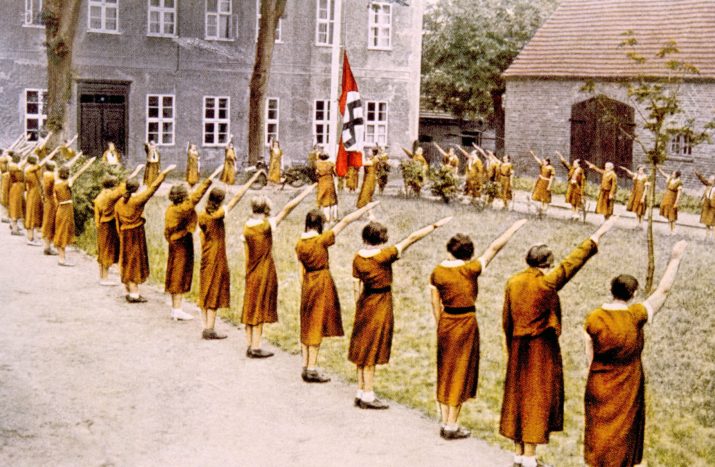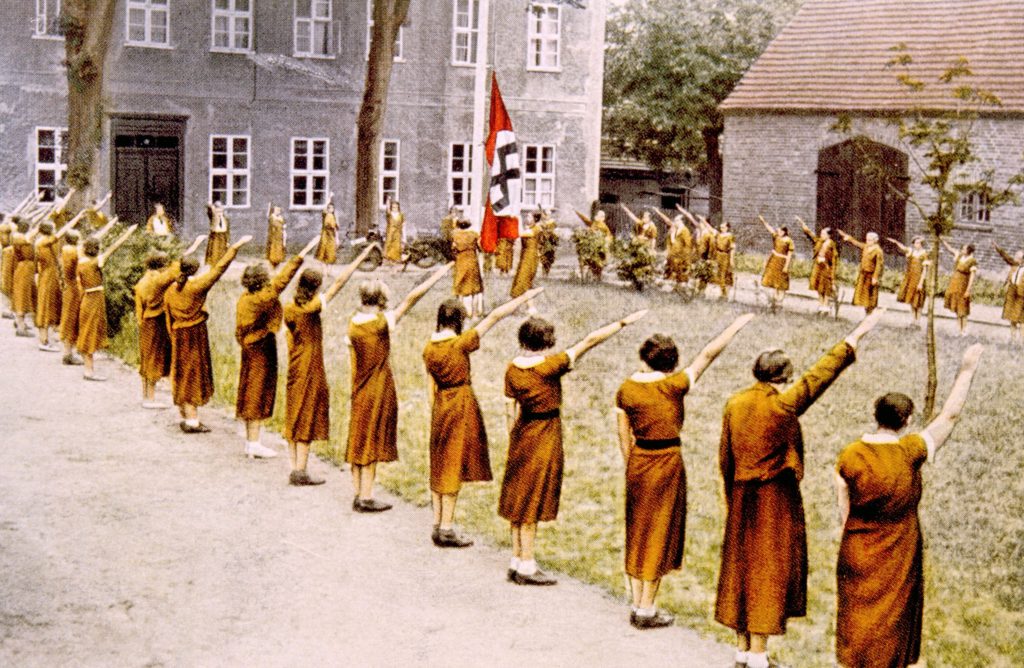

For decades after the Second World War, both the public memory and historical study of the German military were dominated by what has come to be termed the myth of the “clean” Wehrmacht.[1] This myth held that in contrast to the SS, the army had conducted itself honorably, avoided participation in crimes, and retained a healthy distance from the Nazi regime. Historians have traced its origins to the statements of former generals, public figures, and veterans’ organizations, as well as the exigencies of Cold War politics.[2]
By the 1970s, assumptions regarding the army’s innocence began to unravel in the face of meticulous scholarship that focused on the army’s conduct during its campaign against the Soviet Union, in which the majority of its soldiers fought. In 1978, Christian Streit demonstrated that the Wehrmacht willingly put the Nazis’ racial policy into practice through its merciless treatment of Soviet prisoners of war—over three million of whom perished in German captivity. Over subsequent decades, scholars made the case that the army’s leaders had agreed with the basic outlines of Hitler’s murderous agenda. They also began to acknowledge that the Wehrmacht played an active role in the genocide of Eastern European Jews. By the 1990s and 2000s, historians portrayed the Third Reich’s war in the East as a Vernichtungskrieg, a war of extermination waged by officers and men steeped in Nazi thinking who aggressively carried out Hitler’s vision to re-draw the racial map of Europe. The destruction of thousands of villages in “scorched-earth campaigns,” widespread economic exploitation, mass executions, and wanton disregard for the lives of Soviet civilians and Red Army prisoners are now recognized as the hallmarks of the Wehrmacht’s modus operandi. An influential 1995 exhibition entitled “The German Army and Genocide” brought these findings to the German public.[3]
As evidence of the Wehrmacht’s criminality has mounted, scholars have focused their attention on the question of what motivated the men in its ranks. The most influential explanation, put forward by Omer Bartov, is that soldiers had been inspired by a shared commitment to the Nazi worldview, the product of relentless indoctrination and the brutalizing experiences of the front that seemed in their eyes to confirm the dogma that they were the members of a master race seizing lordship over “sub-human” Eastern Europeans.[4] Other studies have echoed his conclusions.[5]
While the army’s pattern of brutality in the Soviet Union has been well-documented, and much emphasis has been placed on determining why soldiers willingly took part in atrocities, scholars have accorded less attention to the question of how they came to terms with their actions on a moral level, as well as the self-understanding they and their institution cultivated during the war. Did soldiers embrace identities as racial warriors and agents of extermination, or did they see themselves in a different light? What self-image did the Wehrmacht project, for the benefit of its soldiers, the German people, and foreign observers?
Drawing from newly-assembled collections of soldiers’ letters at the Museum für Kommunikation in Berlin, as well as institutional documents from the Military Archive in Freiburg, this article will argue that even as they implemented Hitler’s genocidal vision, Germany’s young men in uniform constructed identities as decent men fighting for a worthy cause against an evil enemy. They did so not only with reference to the principles of Nazi racial ideology, but also familiar moral concepts. In their correspondence with the homeland, they emphasized their virtuous qualities, justified German atrocities, and portrayed themselves as relatively benign, even generous occupiers. On an institutional level, the Wehrmacht worked to safeguard its reputation among other means by issuing orders for restraint, trumpeting the honorable qualities of its men, and occasionally making conciliatory gestures toward the local population.
Studying the Wehrmacht’s efforts at self-justification and the self-portrait it attempted to paint during the war provide insight into the nature of the German military and its conduct on the Eastern Front, as well as the psychology of criminal violence more generally. First, this line of research illustrates that Germany’s armed forces did not rely exclusively on ideology to define itself and motivate its men. It also turned to traditional notions of right and wrong, such as claims of selflessness, justice, and good intensions as it sought to assert a claim to moral, not simply ideological, superiority over its Soviet enemies. Second, this study helps to explain how criminal violence became normative in the Wehrmacht, in particular, how German servicemen reconciled themselves to participation in a criminal war. They did so in part, it will be suggested here, by convincing themselves that they had not truly violated moral boundaries and remained upstanding, civilized men.[6] Finally, research into the army’s moral self-understanding provides insight into how the Wehrmacht myth began, suggesting that its origins lay not in the postwar period, but during the war itself, as German soldiers and officers worked to maintain a thin veneer of honorable conduct and provided a distorted account of their behavior to observers in Germany and around the world.
Starting in the very first days of the conflict, the Wehrmacht’s leaders and propagandists took numerous steps to portray their organization as an honorable, conventional army that played by civilized rules, refrained from unnecessary destruction, and adhered to the precepts of international law. Commanders across the Eastern Front issued a series of orders that called for a measure of restraint toward local inhabitants and POWs. Although these were typically issued on utilitarian grounds—to prevent a violent backlash against the occupiers—they nonetheless generated the impression that the army held itself to high standards and was not simply allowing its men to run wild. The 46th Infantry Division, for instance, condemned a spate of “wild requisitions” of civilian property that had caused “bad blood” with local Ukrainians. Its officers emphasized that the Ukraine was “to be viewed as the living space of a friendly people,” and that soldiers were to behave accordingly. Unauthorized transgressions against civilians were “inexcusable,” the division’s leaders admonished. Any requisitions, they insisted, would have to be paid for, a stipulation that the Wehrmacht High Command had also emphasized in its initial orders for the campaign.[7] In their letters home, German soldiers frequently mentioned that the theft of civilian property was strictly punished in their units, conveying to their loved ones the impression that their organization did not condone such behavior. In reality, most military formations wasted no time in exploiting local economic resources and allowed mass requisitions as long as the proper paperwork was followed. Nevertheless, but orders calling for milder treatment of the population helped to generate the impression that the occupiers operated in a rational, lawful manner.
Alongside orders that provided the illusion that the army was acting with restraint and tolerance, propaganda materials frequently encouraged soldiers to view themselves as upstanding men who belonged to an organization that followed traditional codes of honor. “The cultured world knows that the German soldier at every time and in every place fights openly and honestly,” declared one newspaper for troops in the first weeks of the invasion. “Defamations…cannot dissuade him from the decency of his way of fighting.”[8] Wehrmacht journalists, whose stories reached both the front lines and the home front, insisted time and again that German troops respected the lives, property, and culture of conquered peoples and safeguarded the well-being of Soviet prisoners of war. War reporter Fred Gressenbauer explained that the Germans would have been justified in shooting “sub-human” Soviet officers in the face immediately upon capture, “but we don’t do it. We let the wounded Bolsheviks be bandaged by our medics and let the officers keep their faces. We Germans are humans!” he declared.[9] As they praised the supposed moral qualities of their own side, propagandists unceasingly depicted their Soviet opponents as criminals who violated international conventions. Red troops, so one journalist reported, hid in trees to shoot German soldiers in the back long after the battle had ended, and even mutilated their corpses, “against every human right and every soldierly law.”[10] The army’s propaganda toward the Soviet population, meanwhile, announced that a new dawn of justice and prosperity would replace decades of tyranny under the Stalinist regime. All in all, propagandists depicted the Wehrmacht as an organization that fought not only out of National Socialist conviction but with the certainty that its behavior and its aims conformed to the precepts of traditional morality.
Another way in which the army cultivated an image as an enlightened organization was by taking small steps to improve living conditions for civilians in the USSR. All these efforts paled in comparison to the devastation the Wehrmacht wreaked upon the country during its four-year campaign, but limited gestures of goodwill went a long way toward salvaging the army’s image. The 12th Infantry Division and its parent II Corps were among those formations that began to incorporate measures aimed at “winning over” the population in their areas of control. The division’s records from 1941 and 1942 indicate that it took an active role in rebuilding the local economy, left the population enough horses for the harvest, paid civilian drivers for their services, and worked to ensure that the locals were able to feed themselves. In 1943, it organized a festival on the occasion of the anniversary of the invasion and opened a school for Soviet children.[11] Other units occasionally employed similar strategies; they distributed food, supplied medical care, protected civilians from partisan groups that confiscated local resources, and established holidays complete with candy and games. Much of this activity represented little more than a naked attempt to secure support for the occupation, but measures like these allowed the army to claim, however implausibly, that it was bringing tangible improvements to the lives of Eastern Europeans. Soldiers’ letters and propaganda reports spread the word of the Wehrmacht’s supposed generosity to readers in the homeland, adding to the portrait of the army as a force for good rather than a vehicle of destruction.
As the Wehrmacht took steps on an institutional level to cultivate a morally acceptable image on the world stage, individual German soldiers turned to traditional moral concepts, alongside ideology, to project identities as decent men pursuing a righteous cause. In their letters, they emphasized their commitment to serving the German nation and its Führer, putting duty ahead of personal concerns. Like their fathers in the First World War, they extolled the virtues of bravery and comradeship and described how they and their fellow men in uniform banded together in a selfless community. Continuing to play their peacetime social roles as best they could, soldiers offered financial advice to wives who were now running the family business and admonished their children to behave in their absence. They sent home Christmas, Mother’s Day, and birthday cards, sometimes decorated with flowers or hand-made illustrations. When conditions permitted, they shipped treats to their children and sent extra food, cigarettes, and portions of their paycheck to family members. Despite the deprivations of life on the front, Walter Neuser proudly informed his parents that he and his comrades had started a collection for the Winter Relief Fund, one of the Third Reich’s largest charities.[12] Gestures like these helped troops to assure themselves and their loved ones that even in the face of vast distances and the horrors of the Eastern Front they remained loving fathers, devoted husbands, and obedient sons who embodied the most cherished values of German society.
Even as they emphasized their own worthy qualities, soldiers did not always conceal the fact that their side routinely committed atrocities, including the summary execution of prisoners, the brutal treatment of civilians, and occasionally—although it remained largely a taboo subject—the murder of Soviet Jews. Throughout the war, however, Wehrmacht troops provided their readers with a version of events in which they figured not as criminals but as reasonable men who from time to time were forced to take harsh measures. The killing of prisoners was typically justified as a legitimate response to alleged enemy atrocities or what German servicemen considered the immoral fighting methods of the Soviet armed forces. Like some of his comrades, private H. Henry reported on the horrific conditions endured by Red Army POWs in Wehrmacht captivity. He expressed a measure of sympathy but ultimately concluded that the prisoners were being “treated in accordance with their misdeeds,” he concluded.[13] German troops rationalized anti-Jewish violence as a racial imperative or a necessary response to supposed criminal activity on the part of the victims. When stealing food from civilians—a common occurrence—they cited the hostility of the locals, blamed Stalin’s regime for the Soviet Union’s widespread poverty, or explained that their own supplies were running thin. Murderous campaigns against Soviet partisans that frequently led to the destruction of entire villages were defined as acts of justice against enemies who were no more than simple bandits.
Although they occasionally admitted their participation in crimes and often displayed racist attitudes toward the population, Wehrmacht soldiers also went out of their way to emphasize moments—whether real or imagined—in which they displayed a measure of kindness toward the men and women they encountered in the Soviet Union. Machine-gunner and private first class Hermann H. explained to his family that for one Uzbek prisoner his unit took, “Everything was…a delightful revelation, the treatment by our soldiers, the good German cigarettes, the shelter with light and oven and coziness.”[14] Shortly after his arrival in Russia, Hans-Peter Eckener described giving candy to the child in the house where he quartered. He also handed tobacco to an old man.[15] A few months later, he wrote that German soldiers in the village of Krasnoje gave children candy in exchange for various chores.[16] Mobile radio operator Wilhelm Moldenhauser spoke of sharing vodka and cigarettes with civilians.[17] He also explained in a letter to his wife that without the firewood and coal the soldiers supplied, the Russian family he was staying with would not have survived the winter.[18] Like the conciliatory policies adopted by some army units, such gestures naturally did little to counteract the desolation the army inflicted on the country, but the same soldiers who sometimes recounted acts of barbarity were all too glad to write home about acts of kindness as well. Doing so helped the invaders reassure themselves that they had not become monsters and that their side retained the moral high ground against their enemies.
Even as they waged a campaign of unprecedented brutality, then, the Wehrmacht and its personnel carefully constructed a narrative of the war in which the invaders appeared not only as faithful followers of the Third Reich, but also as a civilized, conventional fighting force that still honored age-old moral traditions. The more they convinced themselves they remained “decent men,” the more the rank-and-file were willing to prosecute the war of extermination without reservations or pangs of conscience. The army’s efforts to justify its actions and shape public perception helped to lay the foundations for the myth of its “clean hands” and obscured the central role it had played in executing Hitler’s genocidal vision.
David Harrisville is a graduate student in the Department of HIstory at the University of Wisconsin-Madison. His research interests include the social, cultural, and intellectual history of modern Europe, mentalities and everyday life in the Third Reich, the Second World War, and the history of morality.
Photo: Nazi Germany, Junge Deutsche Madel, giving the Nazi salute, c.1933 | shutterstock
References
[1] Support for the research that led to this paper was generously provided by the Council for European Studies and the Mellon Foundation in the form of a Mellon-CES Dissertation Complete Fellowship for my dissertation project entitled “Unrighteous Cause: The Moral World of the German Soldier on the Eastern Front and the Wartimes Origins of the Wehrmacht Myth, 1941-1944.”
[2] See especially Wolfram Wette, The Wehrmacht: History, Myth, Reality, trans. Deborah Lucas Schneider (Cambridge, MA: Harvard University Press, 2006), 195–291.
[3] Relevant works on the Wehrmacht’s criminality include Christian Streit, Keine Kameraden: Die Wehrmacht und die sowjetischen Kriegsgefangenen 1941-1945 (Stuttgart: Deutsche Verlags-Anstalt, 1978); Hannes Heer and Klaus Naumann, eds., War of Extermination: The German Military in World War II 1941-1944, trans. Roy Shelton (NY: Berghahn Books, 2000); Alex J. Kay, Jeff Rutherford, and David Stahel, eds., Nazi Policy on the Eastern Front, 1941: Total War, Genocide, and Radicalization (University of Rochester Press, 2012).
See Hamburger Institut für Sozialforschung, Verbrechen der Wehrmacht. Dimensionen des Vernichtungskrieges 1941-1944. Ausstellungskatalog (2002).
[4] Omer Bartov, The Eastern Front, 1941-45, German Troops and the Barbarisation of Warfare (Hong Kong: MacMillan, 1985); Omer Bartov, Hitler’s Army: Soldiers, Nazis, and War in the Third Reich (NY: Oxford University Press, 1991).
[5] See for example Stephen Fritz, Frontsoldaten: The German Soldier in World War II (University Press of Kentucky, 1995).
[6] On the psychological mechanisms underlying this phenomenon, see especially Claude Steele, “The Psychology of Self-Affirmation: Sustaining the Integrity of the Self,” in The Self in Social Psychology. Key Readings in Social Psychology, by Roy Baumeister (New York: Psychology Press, 1999), 372–90; Albert Bandura and Claudio Barbaranelli, “Mechanisms of Moral Disengagement in the Exercise of Moral Agency,” Journal of Personality and Social Psychology 71, no. 2 (1996): 364–74.
[7] 46th Inf. Div., Abt. Ic., Betr: Verhalten der Truppe gegenüber der ukrainischen Bevölkerung, 18.7.1941, Bundesarchiv-Militärarchiv (hereafter BA-MA) RH 26-46/49. Emphasis in original.
[8] “Der deutsche Soldat kӓmpft ritterlich,“ Ost-Front, 10.7.1941, BA-MA RHD 53/20.
[9] Fred Gressenbauer, “Ein bolschewistischer Offizier. Was gilt ihm das Leben eines Rotgardisten?” Ost-Front, 6.8.1941, BA-MA RHD 53/20.
[10] “Wir klagen an! Vor den Grӓbern gemarteter Kameraden,” Ost-Front, 8.7.1941, BA-MA RHD 53/20.
[11] See for example IIAK, Abt Ic, 2.11.1941, Betr: Partisanenbekӓmpfung, BA-MA RH 26-12/244; 12th Inf. Div., Ic activity report for 1.3-30.6.1943, BA-MA RH 26-12/86.
[12] Walter Neuser to parents, 3.3.1942, Museumstifting Post und Telekommunikation (hereafter: MSPT) 3.2002.0947.
[13] H. Henry to unspecified recipients, 18.10.1941, MSPT 3.2002.0382.
[14] See Hermann H. to parents and sisters, 8.10.1942, MSPT 3.2002.1271.
[15] Hans-Peter Eckener to mother, 9.3.1942, MSPT 3.2002.0307.
[16] Hans-Peter Eckener to unknown recipient (most likely mother or father), 12.7.1942, MSPT 3.2002.0307.
[17] Wilhelm Moldenhauser to Erika, 17.9.1941 and 23.12.1941, in Jens Ebert, ed., Im Funkwagen der Wehrmacht durch Europa: Balkan, Ukraine, Stalingrad: Feldpostbriefe des Gefreiten Wilhelm Moldenhauser 1940-1943 (Berlin: Trafo, 2008).
[18] Wilhelm Moldenhauser to Erika, 7.1.1941, Ibid.
Published on December 1, 2016.




